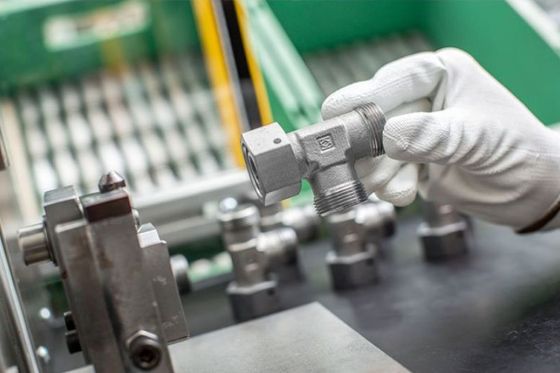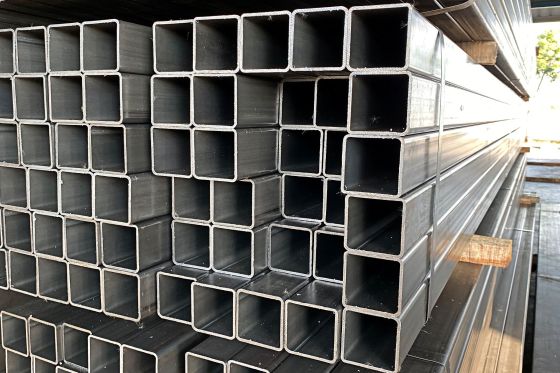Table of contents
- Why corrosion protection is crucial
- What actually is corrosion?
- Types of corrosion
- The salt spray test - how it works
- Our new testing capacities:More samples, more comparability
- Quality assurance for STAUFF products
- Other corrosion tests and their advantages
- Why we rely on the salt spray test
- Our claim: Reliable solutions for our customers
- FAQ
Why corrosion protection is crucial
Whether in mechanical engineering, hydraulic systems or pipework construction - components are often exposed to harsh conditions during use. Moisture, salt, temperature fluctuations or chemical influences attack metals and can lead to corrosion. The consequences are not only visually unattractive, but can also impair safety and functionality.
This is particularly true for outdoor and heavy-duty applications, for example:
mobile construction machinery
Agriculture and forestry
Truck and commercial vehicle hydraulics
Ship and harbour hydraulics
Offshore platforms
Oil and gas industry
Wind turbines
Hydraulic steel construction
Coastal and flood protection systems
Wherever components are permanently exposed to moisture, salt spray or splash water, reliable corrosion protection is crucial.
For our customers, this means that corrosion-resistant products extend the service life of systems, reduce maintenance work and lower operating costs in the long term. In order to guarantee this quality in the long term, we not only have to develop surface coatings, but also test them reliably.
What actually is corrosion?
Corrosion is the chemical or electrochemical attack on metals by their environment. The most common form is rust formation in steel, caused by reaction with water and oxygen.
Consequences of corrosion:
Weakening of the component strength
Leaks in hydraulic systems
Malfunctions
Increased maintenance and replacement costs
Particularly vulnerable applications:
Mobile construction machinery and forestry equipment
Agricultural machinery and trailers
Offshore and marine applications (salt water, spray)
Harbour facilities and cranes
Oil and gas industry (pipelines at risk of splashing water)
Wind power and open-air systems
Coastal infrastructure
Types of corrosion
Corrosion can occur due to various causes and circumstances. A distinction is therefore made between several types:
Surface corrosion (uniform corrosion)
Widespread, surface is removed evenly, e.g. uniform rust coating
Pitting corrosion (pitting)
Very localised and deep, leads to punctual breakthroughs, critical for pressure pipes
Crevice corrosion
Occurs in narrow gaps or overlaps, difficult to access and visible
Contact corrosion (galvanic corrosion)
Between different metals in a conductive electrolyte, e.g. steel and aluminium without insulation
Stress corrosion cracking
Combination of mechanical stress and corrosive environment, leads to sudden failure
Intergranular corrosion
Along grain boundaries in the microstructure, critical for certain stainless steels
Protective measures
Galvanic coatings (e.g. zinc/nickel)
Paintwork and powder coatings
Anti-corrosion oils and waxes
Use of corrosion-resistant materials such as stainless steel
Constructive corrosion protection (avoidance of gaps)
The salt spray test - how it works
The salt spray test is one of the most frequently used methods worldwide for testing the corrosion resistance of materials and coatings under standardised conditions. It is internationally standardised, including in ISO 9227 and ASTM B117.
Briefly explained
In a special test chamber, a 5 % sodium chloride solution (salt water) is finely atomised and continuously sprayed onto the test parts as a mist. The ambient temperature is kept constant at 35 °C. This simulates an aggressive, corrosive atmosphere and thus enables a comparable assessment of the protective effect of coatings.
Procedure of the test with us
Preparation: Components are carefully cleaned and placed in the chamber.
Spraying: The salt fog solution is distributed as a fine mist over the test surfaces.
Test duration: Depending on the application and the protection class, e.g. over 3000 hours.
Cleaning: After the test, the samples are rinsed with deionised water.
Evaluation: Visual inspection for signs of corrosion such as rust, blistering or infiltration of the coating.
Documentation: All results are recorded and analysed in detail.
The advantage of the procedure lies in its standardisation and comparability. This means that different coatings or supplier components can be objectively compared.
Our new testing capacities: More samples, more comparability
We have specifically expanded our testing capabilities with a modern salt spray test rig from Erichsen. This doubles our testing capacity.
What does this mean in concrete terms?
More samples can be tested at the same time
Possibility of serial testing with systematic variants
Comparison of our own products with components from suppliers or competitors
Faster availability of reliable results for development and quality assurance
This investment is part of our commitment to the highest product quality and customer satisfaction. Because only with sound tests can we ensure that our surface coatings provide long-term protection in practice.
Quality assurance for STAUFF products
A particular focus is on optimising our zinc/nickel coatings. These are used in many of our products to ensure outstanding corrosion protection under high mechanical stress.
With the new test bench we can:
Systematically compare different coating formulations
Making data-based decisions for series release
Checking the quality of purchased parts and comparing them with our standards
Support our customers with clear, reliable statements about the durability of our products
The goal: Consistently high quality in the long term - regardless of batch size, production location or supplier.
We therefore test specifically for real loads that occur in applications in which our products are installed:
Hydraulic systems in outdoor use (construction and agricultural machinery)
Coastal areas and harbour facilities with high salt pollution
Offshore platforms and shipbuilding with salty spray
Industrial plants with chemically polluted air
Outdoor wind power and energy systems
These practical tests ensure that our coatings can withstand the challenges of a wide range of industries.
Further corrosion tests and their advantages
In addition to the classic salt spray test (SSNT) in accordance with ISO 9227 / ASTM B117, there are other standardised test methods that are tailored to different requirements. Cyclic tests in particular are considered to be more practical because they reflect realistic weather changes.
Comparison of common corrosion tests
Test | Type | Characteristic | Advantage |
ISO 9227 / ASTM B117 | Constant (static) | Permanent salt spray atmosphere at 35 °C | Simple, fast, easy to compare |
ISO 16701 | Cyclic | Alternating salt spray, wet and dry phases | More realistic simulation |
SAE J2334 | Cyclic (Automotive) | Especially for automotive engineering, incl. thermal cycling | Practical for vehicles |
Explanations
ISO 16701 (Accelerated cyclic corrosion test): Simulates alternating loads caused by salt spray, high humidity and drying. The corrosion mechanisms are more similar to real outdoor conditions and are recommended for components permanently used outdoors.
SAE J2334 (Cosmetic Corrosion Lab Test): Specially developed for the automotive industry, this method tests cosmetic corrosion (rust infiltration on painted components) under winter conditions (road salt, moisture, temperature fluctuations).
Why STAUFF relies on the salt spray test
The salt spray test in accordance with ISO 9227 / ASTM B117 is the appropriate standard procedure for our hydraulic components and connecting elements.
Reasons
Globally standardised and recognised with reproducible conditions
Good comparability of results - internally and with competitor and supplier components
Perfectly suited for our zinc/nickel coatings, which are developed for extreme outdoor and industrial applications
Expanded testing capacities allow more flexible and systematic use of this test
In this way, we ensure that our coatings provide reliable protection under the toughest conditions - whether in agricultural machinery, offshore facilities or wind turbines.
Why we rely on the salt spray test
The salt spray test in accordance with ISO 9227 / ASTM B117 is the appropriate standard procedure for our hydraulic components and connecting elements.
Reasons:
Globally standardised and recognised with reproducible conditions
Good comparability of results - internally and with competitor and supplier components
Perfectly suited for our zinc/nickel coatings, which are developed for extreme outdoor and industrial applications
Expanded testing capacities allow more flexible and systematic use of this test
In this way, we ensure that our coatings provide reliable protection under the toughest conditions - whether in agricultural machinery, offshore facilities or wind turbines.
Our claim: Reliable solutions for our customers
The demands on surface coatings are increasing worldwide - due to tougher operating conditions and stricter standards. By expanding our testing capacities, we are ensuring that we can continue to respond to these requirements in a competent and fact-based manner in the future.
For our customers, this means
More safety in the application
Traceably tested quality
Longer product service life
Lower maintenance and replacement costs
Investments in our testing technology are investments in the future - and a clear commitment to quality and reliability.
FAQs
What does the salt spray test actually tell us?
How long does such a test take?
That depends on the requirements. We can run test times of over 3000 hours to test high-performance coatings.
Which standards apply?
The most important are ISO 9227 and ASTM B117. They define the conditions for the tests so that results can be compared worldwide.
Why is STAUFF investing in a new test bench?
To be able to test more samples at the same time, to systematically improve our coatings and to ensure consistently high quality - even with growing requirements.

Newsletter registration
Register now and don't miss any new articles!







